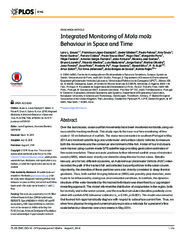| dc.contributor.author | Sousa, Lara L | |
| dc.contributor.author | López-Castejón, Francisco | |
| dc.contributor.author | Gilabert, Javier | |
| dc.contributor.author | Relvas, Paulo | |
| dc.contributor.author | Couto, Ana | |
| dc.contributor.author | Queiroz, Nuno | |
| dc.contributor.author | Caldas, Renato | |
| dc.contributor.author | Dias, Paulo Sousa | |
| dc.contributor.author | Dias, Hugo | |
| dc.contributor.author | Faria, Margarida | |
| dc.contributor.author | Ferreira, Filipe | |
| dc.contributor.author | Ferreira, António Sérgio | |
| dc.contributor.author | Fortuna, João | |
| dc.contributor.author | Gomes, Ricardo Joel | |
| dc.contributor.author | Loureiro, Bruno | |
| dc.contributor.author | Martins, Ricardo | |
| dc.contributor.author | Madureira, Luis | |
| dc.contributor.author | Neiva, Jorge | |
| dc.contributor.author | Oliveira, Marina | |
| dc.contributor.author | Pereira, João | |
| dc.contributor.author | Pinto, José | |
| dc.contributor.author | Py, Frederic | |
| dc.contributor.author | Queirós, Hugo | |
| dc.contributor.author | Silva, Daniel | |
| dc.contributor.author | Sujit, P. B. | |
| dc.contributor.author | Zolich, Artur Piotr | |
| dc.contributor.author | Johansen, Tor Arne | |
| dc.contributor.author | Sousa, João Borges de | |
| dc.contributor.author | Rajan, Kanna | |
| dc.date.accessioned | 2016-09-09T07:23:36Z | |
| dc.date.available | 2016-09-09T07:23:36Z | |
| dc.date.issued | 2016-08-05 | |
| dc.description.abstract | Over the last decade, ocean sunfish movements have been monitored worldwide using various satellite tracking methods. This study reports the near-real time monitoring of fine-scale (< 10 m) behaviour of sunfish. The study was conducted in southern Portugal in May 2014 and involved satellite tags and underwater and surface robotic vehicles to measure both the movements and the contextual environment of the fish. A total of four individuals were tracked using custom-made GPS satellite tags providing geolocation estimates of fine-scale resolution. These accurate positions further informed sunfish areas of restricted search (ARS), which were directly correlated to steep thermal frontal zones. Simultaneously, and for two different occasions, an Autonomous Underwater Vehicle (AUV) video-recorded the path of the tracked fish and detected buoyant particles in the water column. Importantly, the densities of these particles were also directly correlated to steep thermal gradients. Thus, both sunfish foraging behaviour (ARS) and possibly prey densities, were found to be influenced by analogous environmental conditions. In addition, the dynamic structure of the water transited by the tracked individuals was described by a Lagrangian modelling approach. The model informed the distribution of zooplankton in the region, both horizontally and in the water column, and the resultant simulated densities positively correlated with sunfish ARS behaviour estimator (r<sub>s</sub> = 0.184, p<0.001). The model also revealed that tracked fish opportunistically displace with respect to subsurface current flow. Thus, we show how physical forcing and current structure provide a rationale for a predator’s fine-scale behaviour observed over a two weeks in May 2014. | en_US |
| dc.description.sponsorship | The authors are grateful to Tunipex S.A. for making their facilities available and collaborating for tagging sunfish at sea. The work was funded in part by the US Office of Naval Research Global (ONRG) funded under PERSISTS Grant #N62909-14-1-N109. KR and FP were funded by ONR Grant # N00014-14-1-0536 for work on the manuscript. Additional funding from FLAD (the Luso American Development Foundation) is also acknowledged. We are grateful to Liquid Robotics of Sunnyvale, California in particular to Ryan Carlson, Sotiria Lampoudi, Francois Leroy and their operations personnel, for supporting us with an SV2 WaveGlider. We thank Marine Technologies and Federico Zarghetta for the shipboard VSAT communication system. Thanks to IPMA (Instituto Português do Mar e da Atmosfera) and Marinha Portuguesa for logistical support for the experiment. Puertos del Estado facilitated access to ocean data and forecasts used for modelling. Copernicus—Marine environment monitoring service facilitated hydrodynamic modelling outputs of the region. Fundação para a Ciência e a Tecnologia (FCT), Portugal, through a PhD grant to LLS (SFRH/BD/68717/2010); an Investigator Fellowship to NQ (IF/01611/2013) and the SHORE project (Shoreface morphodynamics: an integrated approach) under the contract PTDC/MAREST/ 3485/2012, for the ADCP data. NQ and JS were also funded through the project ‘Marinfo’ co-financed by North Portugal Regional Operational Programme (N2020), under the National Strategic Reference Framework (NSRF) via the European Regional Development Fund (ERDF). AZ and TAJ were funded by the Research Council of Norway through the Centres of Excellence funding scheme, grant number 223254 —AMOS. Lastly, thanks go to High School José Régio, in Vila do Conde, Portugal, especially to science teacher Ana Flora Esteves and her students for their enthusiastic engagement prior to, during and after the field experiment. | en_US |
| dc.description | Publisher's version, source: <a href=http://dx.doi.org/10.1371/journal.pone.0160404>http://dx.doi.org/10.1371/journal.pone.0160404</a>. | en_US |
| dc.identifier.citation | PLoS ONE (2016) 11(8): e0160404 | en_US |
| dc.identifier.cristinID | FRIDAID 1378759 | |
| dc.identifier.doi | 10.1371/journal.pone.0160404 | |
| dc.identifier.issn | 1932-6203 | |
| dc.identifier.uri | https://hdl.handle.net/10037/9652 | |
| dc.language.iso | eng | en_US |
| dc.publisher | Public Library of Science | en_US |
| dc.rights.accessRights | openAccess | |
| dc.subject | VDP::Matematikk og Naturvitenskap: 400::Zoologiske og botaniske fag: 480::Marinbiologi: 497 | en_US |
| dc.subject | VDP::Matematikk og Naturvitenskap: 400::Informasjons- og kommunikasjonsvitenskap: 420::Simulering, visualisering, signalbehandling, bildeanalyse: 429 | en_US |
| dc.title | Integrated Monitoring of Mola mola Behaviour in Space and Time | en_US |
| dc.type | Journal article | en_US |
| dc.type | Tidsskriftartikkel | en_US |
| dc.type | Peer reviewed | en_US |


 English
English norsk
norsk